How to make a decorative putty from an ordinary one at home?
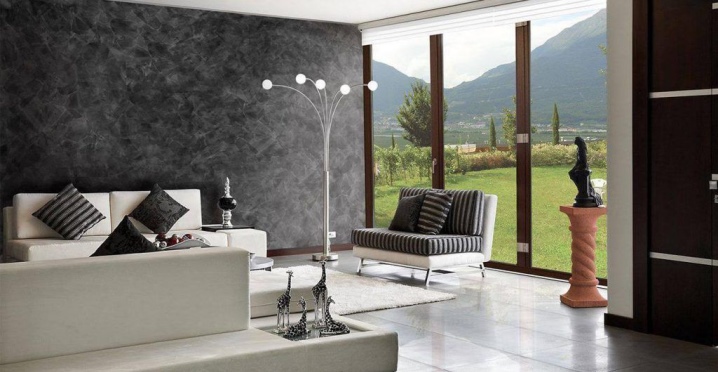
Wall decoration is almost the most important part of the renovation. It's no joke, but the owners of the house will have to look at them from day to day, and therefore the decoration and design of the walls must be approached very responsibly from the first stages of putty. Uneven, poorly plastered walls are hell for a perfectionist.


Features of decorative plaster
Decorative textured plaster from putty has a huge range of advantages:
- easy to do with your own hands;
- for a relatively low cost, you can create an original design of the room;
- the prepared solution is conveniently applied to any surface;
- will last for many years without losing its presentable appearance;
- large selection on the market;
- the putty mixture does not contain toxic substances in the composition, therefore the material is safe and environmentally friendly.

And in order to dispel all doubts at once, let's figure out in more detail what this coating is.
So, the composition of the plaster includes plasticizers - substances that increase the elasticity and plasticity of the material when used - and various additives that increase the "adhesion" of dissimilar surfaces, the so-called adhesion. The consistency of the coating resembles oil, so it can be easily applied and distributed over the surface.
The material fits perfectly on various substrates: brick and concrete walls, drywall and even cement. In addition, decorative plaster based on putty provides heat protection and sound insulation of the room, does not absorb odors. Undeniable advantages: this coating is very easy to care for; its surface is moisture resistant and durable; does not fade over time.
By the way, many designers use this technique to decorate a studio or apartment, because decorative plaster is an easy way to save money on repairs without sacrificing the quality of work. Done right, a regular putty can turn into a stunning fresco. All it takes is your desire and a little bit of diligence!



How to make decorative from ordinary putty
So, when you have seriously decided on the idea of exclusive decoration of the walls of your home, it's time to create! We offer an unsophisticated recipe for the preparation of decorative putty.
In general, the putty is designed to smooth out various wall roughnesses and directly level them.
It can be start and finish:
- The starter putty hides small defects, cracks or scratches.
- Finishing, as, in fact, follows from its very name, brings the already tiled walls to a perfectly smooth state, completing the leveling stage. Thus, it prepares the surface for further decoration.


Decorative plaster, as a rule, is created from a finishing putty (precisely because of its ability to mask defects) and is used as an interior decoration of a room.
Before preparing the mixture, you must first arm yourself with tools: spatulas, sandpaper, sponges, a roller and, for example, a stencil - to create a pattern.
Instead of a roller, you can also use a trowel - this is at your discretion.


To organize the process, the work can be divided into four stages. You have to:
- prepare the surface;
- apply a starting layer;
- to embody the idea (create an invoice);
- finish the walls.
Now let's take a closer look at each stage one by one.

Preparation
Plastering the walls should be given a lot of time and effort, because the quality of the subsequent application of decorative plaster depends on the base.
The entire wall, without avoiding hard-to-reach corners, must be cleaned of old coatings. Fill defects and irregularities with putty and prime the surface. Let it dry.


Base
For decorative finishing, you can easily buy an already prepared putty or a special powder that is diluted in water. Most often, buyers prefer gypsum or cement plaster. They get the most positive reviews. Most likely, the point is in their versatility. In any case, the choice is yours, since the choice is really very large.
To make decorative plaster from lime, gypsum or cement plaster, add a little sand, stone chips, minerals or sugar to the mixture. Various artificial components interact well with polymer plaster, creating various textures when applied: wood, silk and many others.
You need to apply the base in one thin layer (no more than two millimeters). Do not seek to smooth out all imperfections and roughness - they will be leveled in the future.


Design
The main stage of decoration is the direct embodiment of the conceived pattern or texture into reality. All the nuances here depend on the specific type of decorative putty. The only thing that must be taken into account: the applied layer should not be thicker than five millimeters, otherwise, over time, the finish may crack, and all the work will be down the drain.

Home stretch
The finished embossed wall can be varnished or waxed as desired for a glossy effect.


Views
Before deciding on your own design, you should familiarize yourself with all types of decorative plaster. And there are a lot of them and each has its own story and its own zest.
The most extensive classification of plasters is the field of application. So, mixtures are divided into two types: for interior decoration and exterior.
Basically, all decorative plasters are intended for the interior. Such a coating will not withstand strong or abrupt changes on the street.


Versailles
It is more convenient to apply the Versailles decorative plaster from the putty step by step.
Before making a mixture for plaster, stock up on starting and finishing putty, quartz primer, varnish, wax and silver. Having collected all the "ingredients", it will be easier for you to work with the material, especially if you are new to the construction business.
So, first cover the wall with masking tape. Then apply a quartz primer to the surface, in this case it will provide adhesion. While the first coat dries, mix the plaster / putty mixture. To do this, use the finishing and starting mixture, following the recommendations given above.

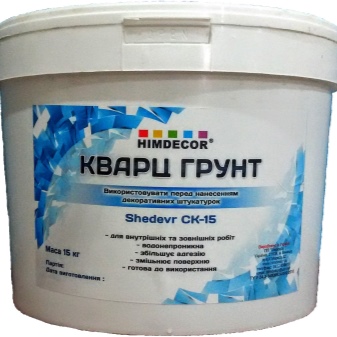
After the primer has dried, paint the wall a neutral color: white or beige. After two hours, add the prepared silverware to the primer or varnish and apply the resulting mixture with a roller. Important: you do not need to press hard on the roller, because the Versailles style involves painting only the upper part of the plaster.
When finishing work, cover the surface with wax or varnish (they give a finish almost equally glossy). Just do not forget to dilute it with water by about a third before using the varnish. Due to the reduced concentration, a film will not subsequently appear on the surface.




Textured
To create textured plaster, let your imagination run wild. In accordance with the idea, both a familiar roller and a brush, notched trowels, a trowel or even a stencil may be useful to you.Plain crumpled paper, a sponge and homemade stamps are also quite suitable for imparting texture.
Apply decorative plaster to the wall in a layer about 2-5 mm thick. After that, add texture with the tools at hand. For example, a small, soft spatula will help create an embossed pattern. In order to achieve this effect, distribute the putty over the surface with chaotic strokes.


The composition of textured plaster is usually complemented by small stones, fibers, wood, mineral chips and mica. This mixture has sufficient adhesion to adhere firmly to wood, concrete, brick and other substrates.
Small defects of the wall are masked due to some natural mineral additives, and therefore you do not have to process the surface before applying the mixture and bring it to perfect smoothness.
Structural plaster can be used to imitate stone, wood, leather or fabric (such as silk).
To cover with such a mixture, no special tools are required - a simple trowel or spatula is enough.


One square meter of area will need about two kilograms of the mixture. Compared to other, more complex types of plaster, this is not at all a lot.
The most famous and popular effects achieved with textured plaster:
- Lamb's wool: interspersed with small stones, the finish looks grainy and rough;
- "Fur coat": it looks very much like a lamb, but rather, it is something like a pile.


Venetian
Perhaps the most beautiful decorative plaster is Venetian. It looks like marble and looks very expensive. However, the very creation of such a texture is quite expensive.
Such material for decoration was invented in the Roman Empire., when one of the builders decided to combine slaked lime with marble dust. The mixture turned out to be very elastic and looked no worse than natural stone on the walls. Natural dyes and components added to the composition provided a special credibility.
Much later, in the Renaissance, which, as you know, was guided by ancient culture and architecture, this type of plaster appeared in the heart of Italy - Venice. There, craftsmen used it instead of expensive marble.
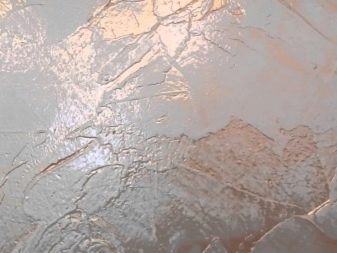

The technique of Venetian decoration was not very simple - it remains so to this day. Although at that time this method of surface treatment was much easier than working with whimsical marble slabs. By the 15th century, everything was decorated with Venetian plaster: walls in palaces, columns near temples, walls and ceilings. Its plus was also the fact that it did not deteriorate from changes in humidity - and in Venice, for objective reasons, this was the main advantage - and how majestic and beautiful it looked.
It was much more convenient to deliver marble dust to Italy than the heaviest marble, so by the dawn of the Renaissance there was a real architectural "boom", and an incredible demand for Venetian plaster was growing.

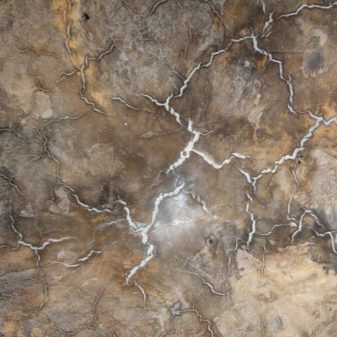
The composition of marble dust, slaked lime and dyes, proven for centuries, remains unchanged to this day. In some mixtures, however, acrylic is now added - a synthetic dye. But experienced people know that a real Venetian coating is absolutely natural and environmentally friendly.
However, this is more a matter of taste.
Cope with Venetian plaster on your own is a very difficult task.but doable. There are countless ways of applying it, so an inexperienced person cannot understand what the result will be in the end. Here, every movement matters: from different strokes - a different pattern. So before the final coating, you should experiment, and this pleasure is far from cheap.


The base under the Venetian plaster must be perfectly smooth. For this purpose, the surface is carefully treated with a latex putty. Then the wall is primed in two layers.The primer provides adhesion, prevents the development of fungus. Once dry, you can start working with the plaster.
Each layer is applied with a different technique, but they are all sanded and smoothed. Also remember to let the layers dry. Finally, either beeswax is applied to the wall (it will create a glossy surface) or synthetic (for a matte finish). The latter is preferable if the room to be decorated is exposed to high humidity (for example, a bathroom).



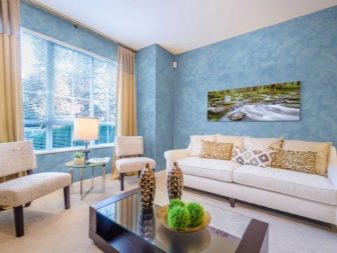
Curly
Figured or embossed decorative plaster is very plastic: it allows you to change the applied pattern. This is the only type of plaster that has this ability.
The coating is easy to polish and grind, it can be used to create truly beautiful textured patterns and bas-reliefs using an ordinary roller. In addition, embossed plaster provides good thermal insulation and performs a protective function.
And most importantly: the embossed finish allows you to save on leveling! It not only hides any defects, but also makes the surface look three-dimensional. Plaster can form protrusions on the wall, so it is advisable not to apply a layer thicker than fifteen millimeters. The plasticity of the material makes it easy to apply it to the wall and create any interesting compositions. For example, imitation of bark, grass, brick looks very cool.



Acrylic
This plaster is made from acrylic resin, a polymer that can often contain inorganic and organic pigments. This gives the mixture a certain color. The composition also includes minerals and modifiers - substances that improve the quality of the mixture.
There is a combination of acrylic and textured plaster.


It includes mica, flax fibers, pebbles. This mixture can be used to decorate concrete, brick, already plastered or wooden surfaces. The textured acrylic mixture is also suitable for outdoor decoration.
In general, acrylic plaster is an option for those who want to simultaneously decorate and paint the walls in a solid color.


Sand
Sand effect decorative plaster consists of ordinary river sand. The final appearance of the treated surface, as in the case of Venetian plaster, depends on the application technique.
Useful properties of sand plaster:
- Moisture resistance. The coating can be subsequently wiped with a damp cloth or sponge - this is quite quick and convenient. The plaster ensures stable moisture exchange and creates a pleasant indoor climate.
- Durability. With regular cleaning and proper use, sand plaster will serve you faithfully for many years.
- Protection. Quartz in the mixture prevents mold or mildew from appearing on the surface.


Created textures and effects
- Sand Dune. This is the name of the resulting shimmering coating in the oriental style. The very fine quartz that is part of the material shines. This shine can be enhanced with pearlescent pastes and tinting.
- "Sandy wind". Sand plaster with broad strokes is applied to the surface in several layers: one on top of the other.


- "Shagreen leather". The drawing is applied using a stencil on the second layer of plaster.
- "Sackcloth". This effect is achieved with a brush.


- "Bark beetle". The design of this type of decorative plaster is a type of wood that seems to be eaten by bark beetles. Sounds a little off-putting, but looks pretty good. The result is achieved due to the appearance of small grooves and cracks on the not yet hardened layer of plaster. Important: this can only be achieved with the correct layer thickness.

The principle of decorating is as follows: circular movements are performed on a fresh coating with a plastic float. Do not be afraid if the mixture sticks to the grater - this is normal. Fifteen minutes later, the wall should be grated again more intensively.After the second approach, the surface will be sufficiently cleaned. But remember that it is important not to go too far - the more approaches with a float you make, the smoother the coating will become.
The original "bark beetle" should remain textured.
At the end of the work, cut off the ugly protruding "crusts" of the plaster with a clerical knife and remove the masking tape.


Design
Wall decor is an extremely individual matter. In this regard, decorative plaster from putty provides freedom of choice and creativity. Creation of different designs will make any room unique and stylish.
For texturing, stone, paint, and any other device for creating an unusual decoration are suitable. With the help of ready-made mixtures, you can achieve the effect of marble, brick wall - whatever your heart desires.


Nowadays, the color of the plaster in the form of a world map is very popular. This design is suitable for a child's room or study. In addition, you can paint the surface with different colors, changing the paint depending on your mood. Refreshing color is always refreshing and inexpensive.
If you are new to the construction industry and have a choice between two types of decorative plaster, it is best to choose the one that is easier to perform. Any even the most ingenuous plaster, done correctly, will look presentable.


Decorating tools
There are several basic tools for decorating walls with plaster from putty yourself at home.
- Roller. One of the easiest ways to create a textured finish is to apply a roller.
- Stencil. This is a tool with a convex pattern that is pressed into the soft, not yet dry putty over the entire surface area. To get a clear pattern, rinse the stencil well in water after each use.
- Putty knife. Surface leveling tool in the form of a flat plate with a handle. Models are available in different sizes and thicknesses for different types of surfaces.

- Trowel. Outwardly, it looks like a spatula: it also consists of a rectangular plate and a handle and serves for laying plaster. With the help of a trowel or a trowel (as it is called by the people), in fact, the same work is done. It is worth making the choice between these tools based on personal considerations. Although experienced repairmen advise using a trowel to apply Venetian plaster.
- Cellophane. You can place a plastic bag or film on a fresh layer of decorative plaster and create a relief yourself - an original and very simple way for practical people.
- Sandpaper. Already dried surface is rubbed with it.
- Brushes.
Using brushes of different thicknesses and densities of pile, you can create a wavy or striped pattern.

Application process
Making decorative plaster with your own hands is quite simple. It is even much easier than gluing wallpaper or laying tiles.
Take a finishing or starter filler in powder form and mix them in equal parts. Add water to the dry mixture and mix the mortar with a construction mixer until smooth. In appearance, the mixture should resemble thick sour cream. Let the solution sit for five minutes and then stir it again.

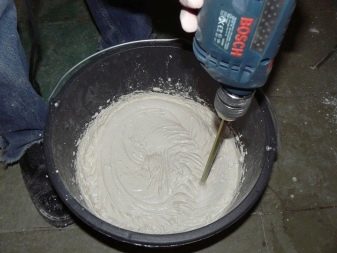
The finished mixture can be placed both on concrete and on drywall, stone and wood surfaces. When preparing to putty, keep all the necessary tools at hand - this will once again save time. With a spatula or trowel, apply the plaster to the wall in thin layers of three millimeters. With a trowel, you can make random strokes to create texture or pattern.
Be careful in corners, door slopes and ceiling skirting boards: all seams must be filled so that the finish is uniform and the cracked finish does not come as a complete surprise to you.
After you have applied the mixture, let the finish sit for two days and allow it to dry properly.Then sand the entire wall with grainy sandpaper, after removing the corners with a spatula. Ultimately, you will get a smooth and textured surface. After cleaning the wall from dust and dirt, re-coat it with a primer and let it dry again.


At the end of the work, when the wall is completely covered with already dried plaster, it is usually varnished or waxed for additional protection and a glossy effect. But you can easily leave the wall for painting.
Depending on the type of decorative plaster, there are many options for techniques and nuances - it is impossible to tell about all of them. Textured - the easiest in terms of application, since it does not need anything but a spatula.


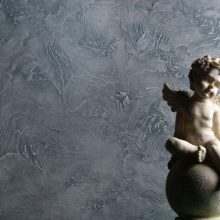
Useful Tips
- In order for the plaster to dry faster, the space must be ventilated after work.
- Since any plaster adheres firmly to the surface, after finishing the finish, you must immediately thoroughly wash the spatula, trowel or stencil.
- Do not forget: the shelf life of any plaster is 6 months. It is better to store the bag with the mixture remaining after work out of the reach of direct sunlight (for example, in the garage or in the attic).
- To create a glossy effect, it is best to use construction wax or varnish. But glazing is also suitable, which will accentuate the relief and make it shiny.
This product should be applied either in a special glove or with a paint brush or sponge.



- To wash the surface with decorative plaster, preferably not with aggressive cleaning agents, but with ordinary soapy water.
For information on how to make decorative plaster with your own hands from ordinary putty, see the next video.













Cool! Thanks for the idea.
The comment was sent successfully.